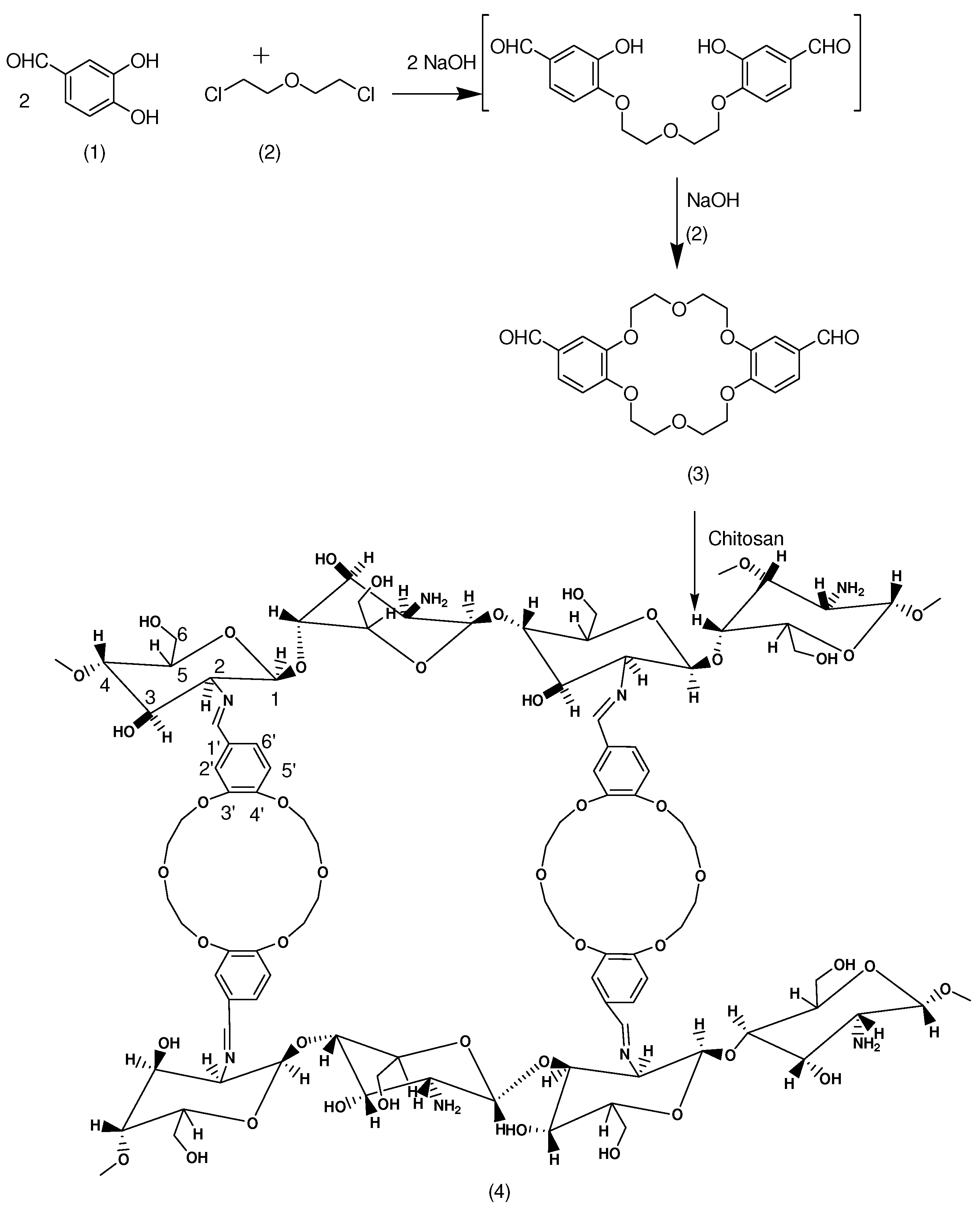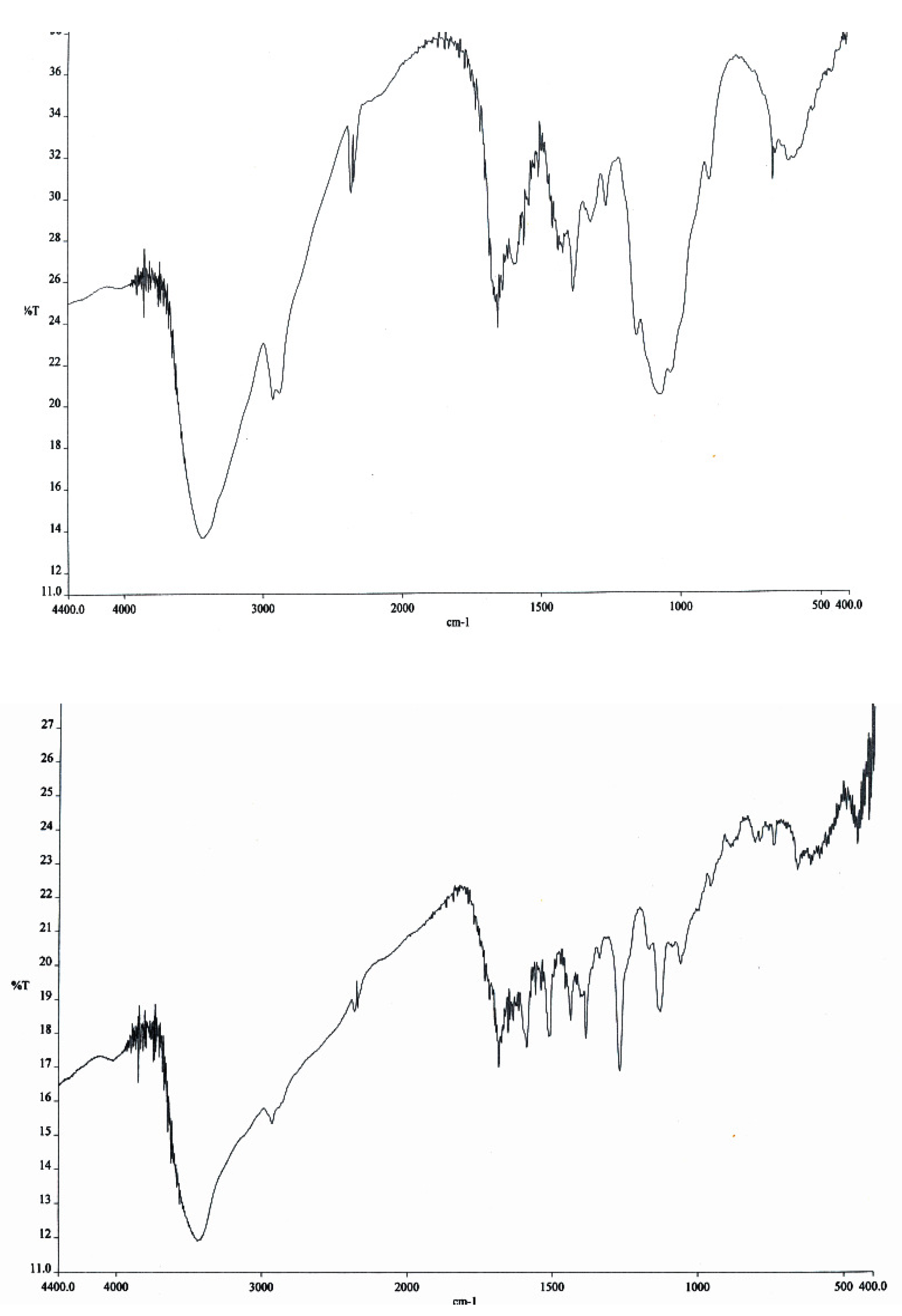Microwave Irradiation-Assisted Synthesis of a Novel Crown Ether Crosslinked Chitosan as a Chelating Agent for Heavy Metal Ions (M+n)
Abstract
:1. Introduction

2. Results and Discussion
2.1. Synthesis and Structural Characterization of Chitosan-Crown Ether

2.1.1. Elemental Analysis
| Compound | N% | C% | H% | DS% |
|---|---|---|---|---|
| CTS | 6.20 | 38.30 | 6.70 | - |
| CCdBE | 3.60 | 46.55 | 6.25 | 42 |
2.1.2. Infrared Analysis

2.1.3. X-ray Diffraction Analysis

2.1.4. Solid-State 13C-NMR Analysis

2.1.5. Scanning Electron Microscopy (SEM) Studies

2.2. Adsorption Behavior
2.2.1. Single Metal Ion Adsorption
| Adsorbent | Adsorption capacities (mmol/g) | |||
|---|---|---|---|---|
| pH 4 | pH 6 | |||
| Pb2+ | Hg2+ | Pb2+ | Hg2+ | |
| CTS | 0.82 | 0.33 | 0.94 | 1.48 |
| CCdBE | 0.99 | 1.10 | 1.18 | 1.58 |
2.2.2. Two Metal Ion Co-Adsorption
| Adsorbent | Adsorption capacities (mmol/g) | Selectivity coefficient (KHg2+/pb2+) | Adsorption capacities (mmol/g) | Selectivity coefficient (KHg2+/pb2+) | ||
|---|---|---|---|---|---|---|
| pH 4 | pH 6 | |||||
| Pb2+ | Hg2+ | Pb2+ | Hg2+ | |||
| CTS | 0.29 | 0.13 | 0.45 | 0.42 | 0.57 | 1.36 |
| CCdBE | 0.12 | 0.96 | 8.00 | 0.13 | 1.38 | 10.62 |
2.2.3. Reusability
3. Experimental Section
3.1. Materials
3.2. Synthesis of Crosslinked Chitosan diBenzocrown Ether (CCdBE) (4)
3.3. Structural Characterization of Chitosan-Crown Ether
3.3.1. Elemental Analysis
3.3.2. Infrared Spectra Analysis
3.3.3. X-ray Diffraction Analysis
3.3.4. Solid-state 13C-NMR Analysis
3.3.5. Scanning Electron Microscopy (SEM) Studies
3.4. Adsorption Experiments
3.4.1. Single Metal Ion Adsorption Experiment
3.4.2. Two Metal Ion Co-Adsorption Experiment
3.4.3. Reusability Experiment
4. Conclusions
Acknowledgements
- Sample Availability: Samples of compounds 3 and 4 are available from the authors.
References and Notes
- Gotoh, T.; Matsushima, K.; Kikuchi, K.I. Adsorption of Cu and Mn on covalently crosslinked alginate gel beads. Chemosphere 2004, 55, 57–64. [Google Scholar] [CrossRef]
- Gotoh, T.; Matsushima, K.; Kikuchi, K.I. Preparation of alginate-chitosan hybrid gel beads and adsorption of divalent metal ions. Chemosphere 2004, 55, 135–140. [Google Scholar] [CrossRef]
- Cao, J.; Tan, Y.; Che, Y.; Xin, H. Novel complex gel beads composed of hydrolyzed polyacrylamide and chitosan: An effective adsorbent for the removal of heavy metal from aqueous solution. Bioresource Technol. 2010, 101, 2558–2561. [Google Scholar] [CrossRef]
- Monier, M.; Ayad, D.M.; Sarhan, A.A. Adsorption of Cu(II), Hg(II), and Ni(II) ions by modified natural wool chelating fibers. J. Hazard. Mater. 2010, 176, 348–355. [Google Scholar] [CrossRef]
- Wu, F.C.; Tseng, R.L.; Juang, R.S. Kinetic modeling of liquid-phase adsorption of reactive dyes and metal ions on chitosan. Water Res. 2001, 35, 613–618. [Google Scholar] [CrossRef]
- Zhoua, L.; Wang, Y.; Liu, Z.; Huang, Q. Characteristics of equilibrium, kinetics studies for adsorption of Hg(II), Cu(II), and Ni(II) ions by thiourea-modified magnetic chitosan microspheres. J. Hazard. Mater. 2009, 161, 995–1002. [Google Scholar] [CrossRef]
- Evans, J.R.; Davids, W.G.; MacRae, J.D.; Amirbahman, A. Kinetics of cadmium uptake by chitosan-based crab shells. Water Res. 2002, 36, 3219–3226. [Google Scholar] [CrossRef]
- Rangel-Mendez, J.R.; Monroy-Zepeda, R.; Leyva-Ramos, E.; Diaz-Flores, P.E.; Shirai, K. Chitosan selectivity for removing cadmium (II), copper (II), and lead (II) from aqueous phase: pH and organic matter effect. J. Hazard. Mater. 2009, 162, 503–511. [Google Scholar] [CrossRef]
- Deans, R.J.; Dixon, B.G. Uptake of Pb2+ and Cu2+ by novel biopolymers. Water Res. 1992, 26, 469–472. [Google Scholar] [CrossRef]
- Kurita, K.; Sannan, T.; Iwakura, Y. Studies on Chitin. VI. Binding of Metal Cations. J. Appl. Polym. Sci. 1979, 23, 511–515. [Google Scholar] [CrossRef]
- Loretz, B.; Bernkop-Schnurch, A. In vitro evaluation of chitosan-EDTA conjugate polyplexes as a nanoparticulate gene delivery system. AAPS J. 2006, 8, E756–E764. [Google Scholar] [CrossRef]
- Masri, M.S.; Randall, V.G.; Pittman, A.G. Removal of metallic ions by partially polyamine polymers. Polym. Preprints-Am. 1978, 19, 483–488. [Google Scholar]
- Jin, L.; Bai, R. Mechanisms of lead adsorption of chitosan/PVA hydrogel beads. Langmuir 2002, 18, 9765–9770. [Google Scholar] [CrossRef]
- Schmuhl, R.; Krieg, H.M.; Keizer, K. Adsorption of Cu(II) and Cr(VI) ions by chitosan: kinetics and equilibrium studies. Water SA 2001, 27, 1–8. [Google Scholar]
- Guibal, E.; Jansson-Charrier, M.; Saucedo, I.; Le Cloirec, P. Enhancement of metal ion sorption performances of chitosan: effect of the structure on the diffusion properties. Langmuir 1995, 11, 591–598. [Google Scholar] [CrossRef]
- No, H.K.; Meyers, S.P.J. Crawfish chitosan as a coagulant in recovery of organic compounds from seafood processing streams. J. Agric. Food Chem. 1989, 37, 580–583. [Google Scholar] [CrossRef]
- Yi, Y.; Wang, Y.; Liu, H. Preparation of new crosslinked chitosan with crown ether and their adsorption for silver ion for antibacterial activities. Carbohydr. Polym. 2003, 53, 425–430. [Google Scholar] [CrossRef]
- Xing, R.G.; Liu, S.; Yu, H.H.; Guo, Z.Y.; Wang, P.B.; Li, C.P.; Li, Z.; Li, P.C. Salt-assisted acid hydrolysis of chitosan to oligomers under microwave irradiation. Carbohydr. Res. 2005, 340, 2150–2153. [Google Scholar] [CrossRef]
- Sha, Y.W.; Wang, Y.; Ge, J.; Wang, X. Application of microwave irradiation in the synthesis of heterocyclic compounds. Chin. J. Org. Chem. 2001, 21, 102–115. [Google Scholar]
- Wada, F.; Hirayama, H.; Namiki, H.; Kikukawa, K.; Matsuda, T. New applications of crown ethers. II. Synthesis of 4′-Formylbenzocrown Ethers. Bull. Chem. Soc. Jpn. 1980, 53, 1473–1474. [Google Scholar] [CrossRef]
- Samuels, R.J. Solid-state characterization of the structure of chitosan films. J. Polym. Sci. Part B: Polym. Phys. 1981, 19, 1081–1105. [Google Scholar]
- Yen, M.-T.; Yang, J.-H.; Mau, J.-L. Physicochemical characterization of chitin and chitosan from crab shells. Carbohydr. Polym. 2009, 75, 15–21. [Google Scholar] [CrossRef]
- Tang, X.-H.; Tan, S.-Y.; Wang, Y.-T. Study of the synthesis of chitosan derivatives containing benzo-21-crown-7 and their adsorption properties for metal ions. J. Appl. Polym. Sci. 2001, 83, 1886–1891. [Google Scholar]
© 2010 by the authors; licensee MDPI, Basel, Switzerland. This article is an open access article distributed under the terms and conditions of the Creative Commons Attribution license (http://creativecommons.org/licenses/by/3.0/).
Share and Cite
Radwan, A.A.; Alanazi, F.K.; Alsarra, I.A. Microwave Irradiation-Assisted Synthesis of a Novel Crown Ether Crosslinked Chitosan as a Chelating Agent for Heavy Metal Ions (M+n). Molecules 2010, 15, 6257-6268. https://doi.org/10.3390/molecules15096257
Radwan AA, Alanazi FK, Alsarra IA. Microwave Irradiation-Assisted Synthesis of a Novel Crown Ether Crosslinked Chitosan as a Chelating Agent for Heavy Metal Ions (M+n). Molecules. 2010; 15(9):6257-6268. https://doi.org/10.3390/molecules15096257
Chicago/Turabian StyleRadwan, Awwad A., Fars K. Alanazi, and Ibrahim A. Alsarra. 2010. "Microwave Irradiation-Assisted Synthesis of a Novel Crown Ether Crosslinked Chitosan as a Chelating Agent for Heavy Metal Ions (M+n)" Molecules 15, no. 9: 6257-6268. https://doi.org/10.3390/molecules15096257




